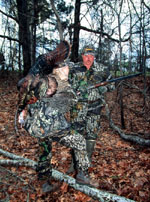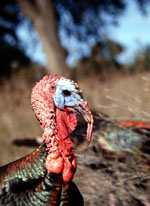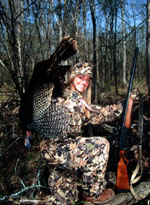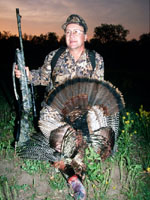
|
Features
|
|
|
|
Books
|
|
|
|
Fun & Games
|
|
|
|
Contact Us
|
|
|
John's Journal... Entry 135, Day 5
TALKING TURKEY WITH THE EXPERTS
The Owners Of Knight & Hale Game Calls Talk Turkey
 EDITOR'S
NOTE: To help those of us who are frustrated more often than not by
EDITOR'S
NOTE: To help those of us who are frustrated more often than not by
America's most famous game bird, I posed some questions to several of
the nation's top turkey hunters and turkey authorities. Today, Harold
Knight and David Hale, the founders of Knight & Hale Game Calls, answer
questions.
Question: Harold, what is the most effective call to
use to call a gobbler in quickly?
Answer: Without a doubt, I have called more turkeys cutting than with
any other type of call. Cutting is a series of fast clucks or the beginning
of a cackle without actually going into a cackle. It is the sound a hen
makes when she wants to mate. If the cutting is given with a real high
pitch, I believe the old gobbler really thinks the hen is excited and
ready for mating.
 Question:
Harold, is cutting always the best call to give?
Question:
Harold, is cutting always the best call to give?
Answer: No, and that's the reason a good turkey hunter should know how
to make many calls. The difference between being a good turkey hunter
and a great turkey hunter is being able to figure out which call to use
when. In my opinion, cutting is the most effective call on most turkeys
in many regions and under a wide variety of circumstances. But cutting
won't always work anytime or any place.
 Question:
Harold, how many turkey calls should a hunter carry with him into the
woods?
Question:
Harold, how many turkey calls should a hunter carry with him into the
woods?
Answer: That's an important question. Although my answer may sound somewhat
ridiculous, I will explain. A turkey hunter needs either an owl hooter
or the ability to hoot like an owl to try to get a turkey to gobble without
coming to the hunter. When the hunter knows where the turkey is, he can
move quickly to the bird to attempt to set up to call the tom. I also
believe a turkey hunter requires a crow call and a hawk call -- two calls
that can be effectively used to get a turkey to gobble later in the morning
or in the middle of the day. Next, I think a turkey hunter needs a mouth
caller, because under some circumstances, he must be able to call a turkey
without using his hands, as he must on a friction call. A mouth call is
probably the most versatile call of all. And the sportsman needs several
different types of mouth calls. Sometimes a gobbler will come to a raspy
call when he won't come to a sweet or smooth call. I believe a hunter
should also have on hand a box call and a slate call. Often the slate
will work when nothing else will, or the box will when all else fails.
So, as you can see, I am a firm believer in a hunter having several different
types of calls to be effective.
However, if I had to choose one call to cover all turkey
hunting situations and all types of turkey hunters with varying skill
levels, it would be the push button call. Even a child can work the push
button call. One season I had an 11-year-old call and kill his own turkey
with a push button. I have been so impressed with those little calls that
I've started utilizing them myself and have discovered them to be deadly.
They are easy to use, and most importantly-they will call turkeys.
 Question:
Harold, when there is a great deal of
Question:
Harold, when there is a great deal of
turkey-hunting pressure, how do you compete for the gobblers?
Answer: I don't because I believe turkeys are pretty smart critters. When
there are many hunters in the woods trying to take them, they wise up
quickly. Turkeys are aware that most hunters hunt in the mornings and
in the afternoons, which makes these times the most dangerous for them.
I think that's when the toms become more cautious and wary. Therefore,
when I find myself having to hunt areas with high hunter pressure, I give
the other hunters the mornings and the afternoons, and I hunt in the middle
of the day. I do very little calling then, but a lot of waiting and looking.
Most of the time the tom won't gobble when he comes in to where I am waiting.
I may hear him drum or strut, or he may come in silently and just appear.
But I have found in high pressure areas that hunting in the middle of
the day is the most effective.
Question: David, we've mainly been talking about calling
to turkeys, yet most turkey experts agree calling is only 10 to 25 percent
of what is required for taking a turkey. How do you bag a bird if you
don't call to him?
Answer: I killed five gobblers before I ever saw a turkey call. I thought
turkeys were like other critters and could be hunted like other animals.
So I started going into the woods, listening for turkeys to gobble and
attempting to follow them through the woods. I soon learned where they
wanted to go and what they wanted to do. Once I understood the gobbler's
movement patterns, I would sit down on a route the bird normally took
every morning. If he followed that same pattern, he would walk right in
front of me, and I would shoot him. I believe if a man knows how to hunt
a turkey, he will have a much better chance of killing a tom than if he
just knows to call a turkey.
Check back each day this week for more about Talking With Turkey Experts...
Day 1 - Tom Kelly on Turkey
Hunting
Day 2 - Lovett Williams On Becoming A Turkey
Hunter
Day 3 - Rob Keck On Tough Turkeys
Day 4 - Bill Harper On Bagging Gobblers
Day 5 - The Owners Of Knight & Hale Game
Calls Talk Turkey